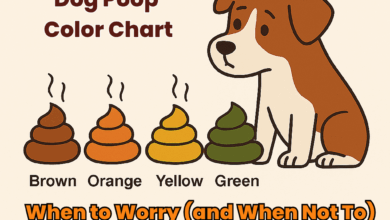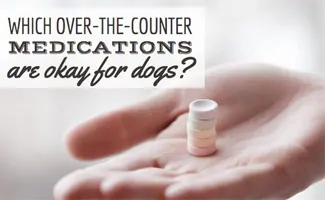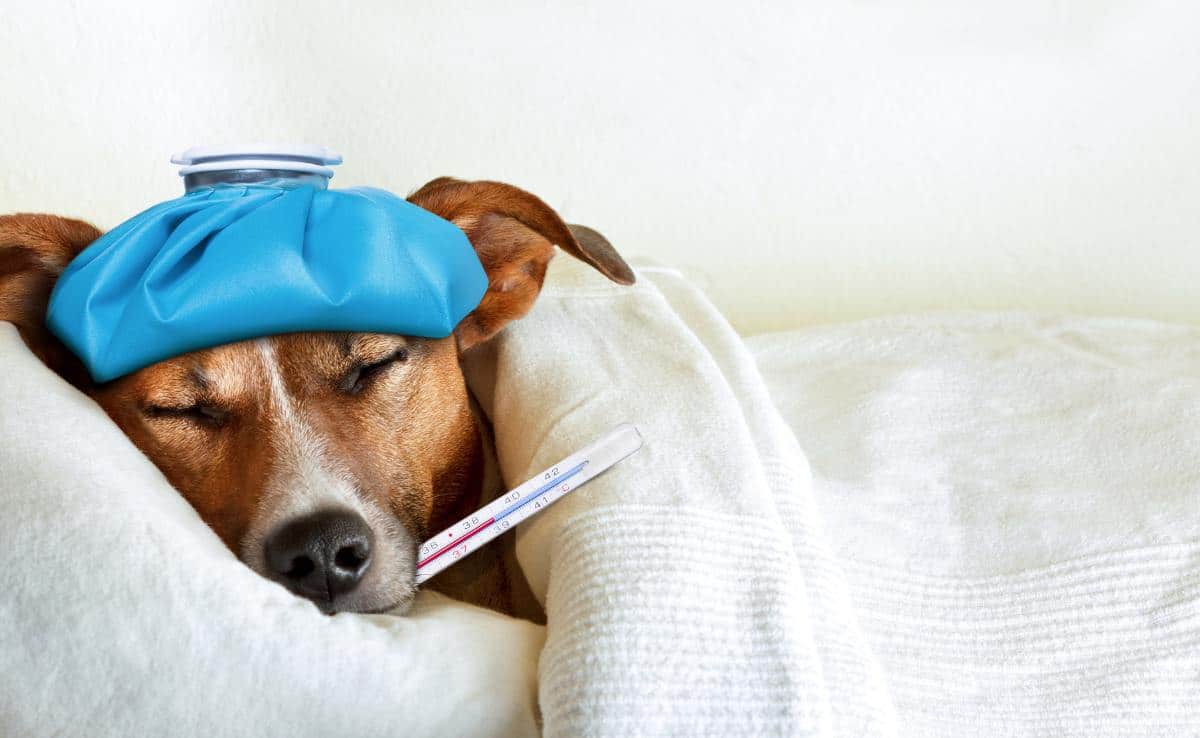How to Clean Dogs’ Ears Without a Meltdown (Yours or Theirs)
When you purchase through links on our site, we may earn a commission. Here’s how it works.
Let’s talk dirty… ears. Yep, your pup’s adorable, floppy, furry ears might just be hiding a gross secret: wax, gunk, bacteria, and even tiny critters (hello, ear mites). Learning how to clean dogs’ ears is an essential part of grooming for any breed.
Table of Contents
Regular ear cleaning isn’t just about hygiene. It’s about keeping your dog healthy and avoiding that funky smell that follows them around like a bad habit.
Why Should You Care About Dirty Dog Ears?
Imagine skipping showers for a month. It’s gross, right? That’s basically what it’s like for a dog with unclean ears. Because of their curved canals, dog ears are a perfect hideout for bacteria, yeast, ear mites, and parasites.
Left unchecked, that innocent ear wax can lead to full-blown ear infections, which are painful, smelly, and expensive to treat.
If your pup’s ears smell like corn chips gone rogue or you see discharge, redness, or swelling, don’t ignore it. It’s time to play doggy ear detective.
Dogs With Dirty Ears: Who’s Most at Risk?
Some dogs are basically born with ear problems on speed dial. Breeds with floppy, heavy ears, think Cocker Spaniels, Poodles, Basset Hounds, and Golden Retrievers, are especially prone. Those velvety flaps trap heat and moisture like a sauna, creating a five-star resort for yeast and bacteria.
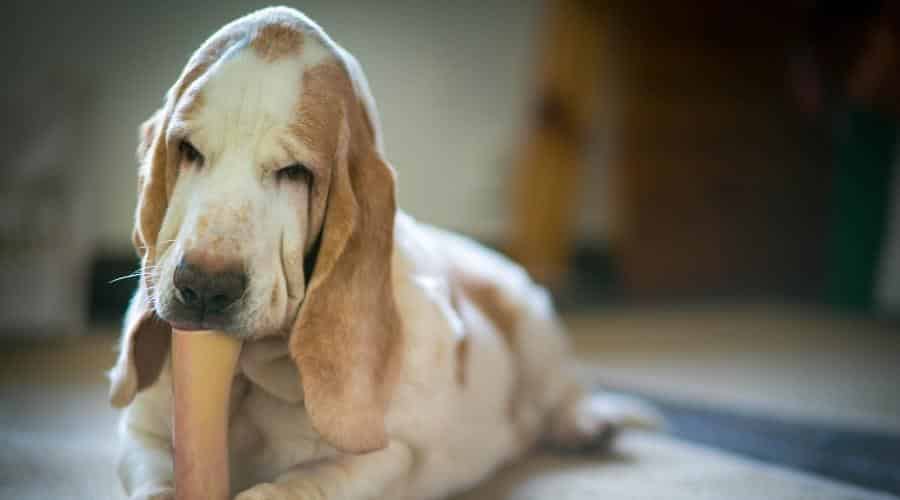
Dogs with allergies, whether environmental or food-related, often suffer from chronic ear inflammation, too. Their immune systems go haywire, triggering excess wax production and swelling that make infection more likely.
Even breeds with upright ears aren’t off the hook. Active dogs who love swimming or rolling in everything nature has to offer can also end up with ear gunk and trapped moisture.
Long story short? Every dog, regardless of breed or lifestyle, needs regular ear checks. Catching issues early can save your pup pain and save you a lot of money and mess.
How To Clean Dogs’ Ears
Need to know how to clean dog ears? It’s essential to attend to ear infections in our canine companions. Leaving a dog’s ear infections unattended can lead to hearing loss or other possible damage.
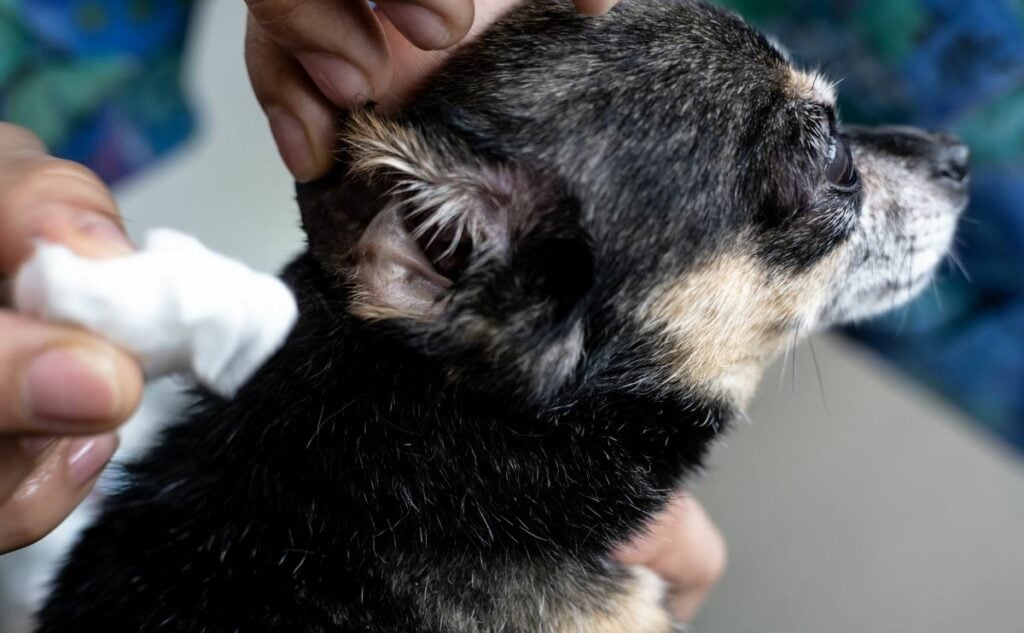
Before you begin cleaning, you’ll want to purchase a trusted cleaning solution and have plenty of cotton balls nearby. Do not use cotton swabs because they can push debris further into the ear. Wash your hands before you start and wear gloves so you don’t risk further problems. Now, you’re ready to begin cleaning.
- Start on the outside and work your way into the ear. Be sure to clean out all areas of the ear you can reach.
- Wet a cotton ball with the cleaner and wipe the inside of your dog’s ear flap.
- Add cleaning solution to another cotton ball and clean the inside part of the ear. Stop when you feel any resistance. You don’t want to push too far into the ear and cause damage. Although the canine ear canal is much longer and shaped differently from ours, it’s easier to harm the eardrum.
- If you notice the cotton balls are extremely dirty or you notice a foul smell, you may want to consider scheduling an appointment with your veterinarian.
- Don’t forget to give your dog lots of treats and attention for being so good.
Infographic: How to Clean Dogs’ Ears
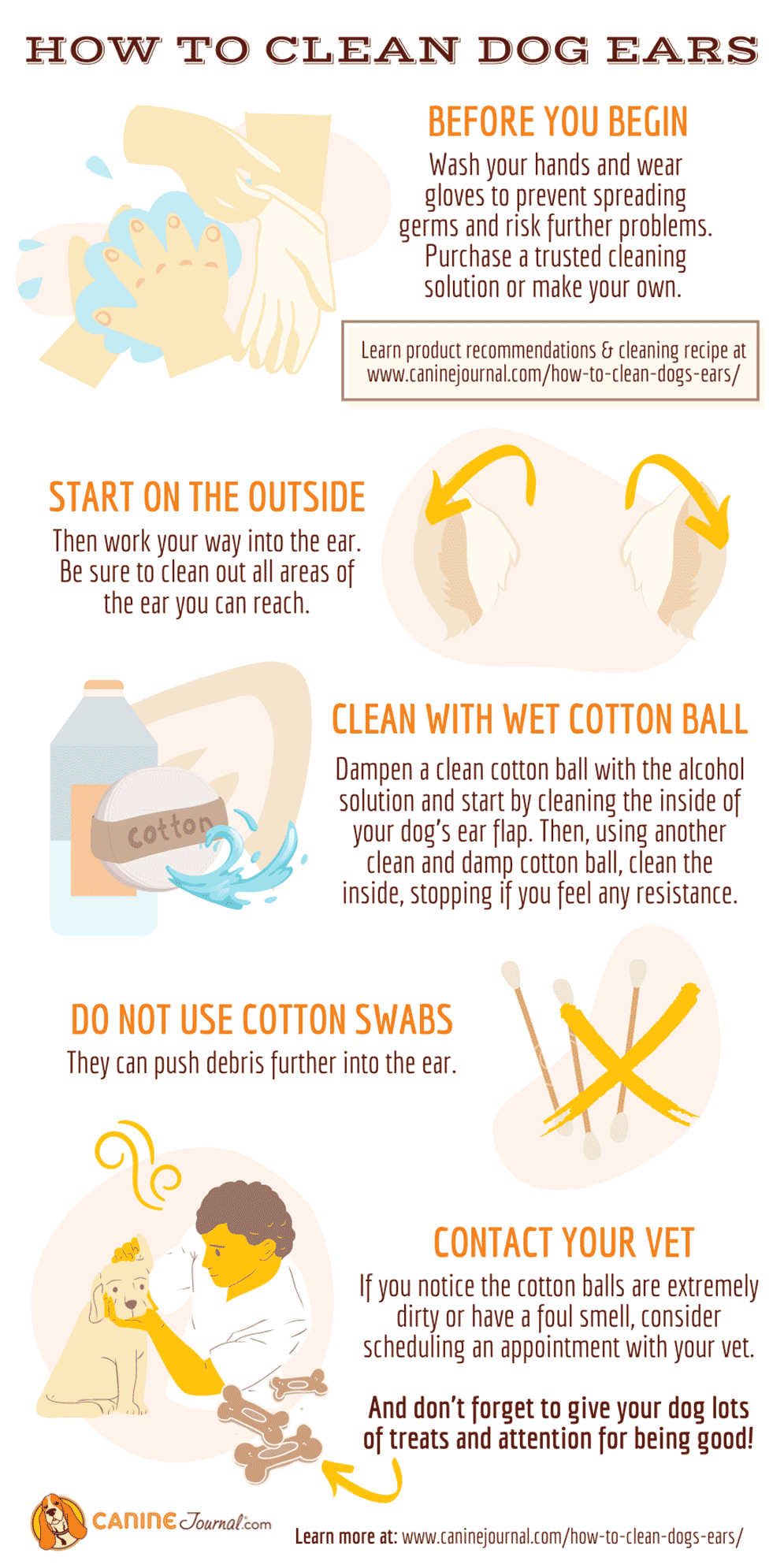
Check With Your Vet First
Don’t attempt to clean your dog’s ears if you don’t feel comfortable with the process. Rather, schedule an appointment with your veterinarian for a cleaning. Watch your vet perform the cleaning and ask questions during the process.
Once your vet has instructed you, you’ll have the confidence and knowledge to clean them yourself when your dog gets dirty ears. If you have concerns about the cost of care, reduce those costs with preventative care and a pet wellness plan.
Choosing the Right Ear Cleaner: Top Recommendations
Wondering where you can buy a good ear cleaner for dogs? Two of the highest-rated solutions are the Virbac EPIOTIC Advanced Ear Cleanser and the Zymox Otic Enzymatic Solution. We also recommend the Pet MD Dog Ear Cleaner Wipes to help you gently remove dirt, wax, and debris from your pup’s ears.
Cleaning With Vinegar And Water?
In the short video below, Dr. Marc Smith from Natchez Trace Veterinary Services shares a simple way to clean a dog’s ears using apple cider vinegar and water. He also shares tips on how to prevent ear infections.
Two DIY Ingredients to Skip in Dog Ear Cleaners
If you’re tempted to whip up a homemade cleaner, proceed cautiously. Some well-meaning ingredients can cause serious issues. Two of the most common offenders? Essential oils and baking soda.
- Essential Oils (like tea tree or lavender): They might smell nice, but essential oils can be toxic to dogs, even in small amounts. Undiluted, they can cause burns, nerve damage, or poisoning. Dogs lick everything; don’t take the risk.
- Baking Soda Mixes: Great for deodorizing shoes, terrible for ears. Baking soda can disrupt your dog’s natural ear pH, drying out sensitive skin and making infections more likely. It’s a no-go for canine ear care.
When in doubt, skip the DIY chemistry and call your vet. If your dog’s ears are already red, smelly, or full of gunk, store-bought vet-approved solutions are the safer bet.
How Often Should I Clean My Dog’s Ears?
The ideal cleaning frequency really depends on your dog’s unique traits and lifestyle.
- Dogs with floppy ears are more prone to moisture and debris buildup, which can create a breeding ground for bacteria. These pups may benefit from weekly cleanings to stay ahead of any potential issues.
- If your dog is a frequent swimmer, spends a lot of time outdoors, or has known allergies, they may also require more regular cleanings, even if they don’t have floppy ears. Water trapped in the ears or inflammation from allergies can quickly lead to infections if not addressed.
- On the other hand, dogs with upright ears and minimal wax production, such as German Shepherds or Huskies, might only need a check and occasional cleaning every 3 to 4 weeks.
Ultimately, there’s no one-size-fits-all answer. Start by inspecting your dog’s ears weekly. There is no need to intervene if they look clean and smell fine. But if you notice wax buildup, dirt, or odor, it’s time for a cleaning. And, of course, your veterinarian can help you create a cleaning schedule tailored specifically to your dog’s needs and medical history.
Why Does My Dog’s Ear Smell Like That?
If your dog’s ears are starting to smell like a forgotten sock in a gym bag, there’s probably more going on than just a little dirt. Odor and discharge are red flags that something’s off in the microbial world of your pup’s ears.
Here are the usual suspects:
- Yeast Infections: These thrive in warm, moist environments—especially floppy ears. The smell? Think moldy bread mixed with foot funk.
- Bacterial Infections: More aggressive than yeast, these often come with thick, yellow, or brown discharge and a smell that’ll haunt your nostrils.
- Ear Mites: Tiny, crust-loving parasites that cause intense itching and black, crumbly gunk that looks like coffee grounds.
- Water Trapped in the Ear Canal: After baths or swimming, leftover moisture becomes a breeding ground for bacteria.
- Excess Wax Buildup: Some dogs just overproduce ear wax, which can trap debris and start to smell if not cleaned out.
- Foreign Objects or Foxtails: Grass seeds or tiny bits of debris can get lodged deep in the ear, causing irritation, infection, and, you guessed it, nasty smells.
If your dog’s ear discharge looks like slime from a sci-fi movie or the smell makes your eyes water, it’s time to call the vet. Fast.
Ear Mites: Tiny Pests, Big Problems
If your dog is scratching like mad and shaking their head nonstop, ear mites might be the culprits. These microscopic invaders cause intense itching and inflammation and, if left untreated, can lead to painful ear hematomas. They’re highly contagious to other pets (but not humans), so don’t ignore the signs.
From Cheese Stench to Vet Bench: Bear’s Ear Disaster
One of our team members shared this unforgettable experience with her black Lab, Bear, a tale of love, goo, and hard-earned lessons.

Let me introduce you to Bear, my big, goofy black Labrador with a heart of gold and ears that could clear a room. I started noticing that every time he snuggled up to me, this overpowering stench was like moldy cheese had married gym socks and moved into his head. Curiosity (and the smell) got the better of me, so I took a peek.
His ears were oozing this thick, yellowish sludge that looked straight out of a sci-fi horror flick. With naive confidence, I grabbed the cleaner, threw on gloves, and attempted a home remedy. Halfway through, Bear shook his head so violently that ear goo splattered the walls, ceiling, and my poor fiddle leaf fig.
Defeated and slightly traumatized, we drove to the vet.
Turns out Bear had a full-on ear infection. Yeast and bacteria had turned his ear canal into a microscopic mosh pit. Thankfully, he healed up with medication and a strict cleaning routine from the vet. The house, however, still carries the faint memory of Eau de Bear.
This was a crash course in learning how to clean dogs’ ears that I never thought I’d have.
– Danielle DeGroot, Rescue Dog Mom & Canine Journal Writer
What’s the Difference Between Ear Wax and an Infection?
Normal wax is light brown and odorless. Infection-related gunk? It’s often dark, sticky, smelly, and paired with other symptoms like redness or pain. If you’re unsure, err on the side of caution and call your vet.
Frequently Asked Questions About How to Clean Dogs’ Ears
Do you still have questions about how to clean dogs’ ears? You’re not alone. Here are some of the most frequently asked questions from fellow pet parents and the answers you’ve been sniffing around for. If you don’t see yours, let us know in the comments.
What are signs that my dog’s ears need cleaning?
Look (and sniff) for:
- A yeasty or sour odor
- Wax buildup or discharge
- Redness or swelling
- Excessive head shaking or scratching
Basically, if your dog is acting like their ears are haunted, it’s time to investigate.
Can I use hydrogen peroxide or alcohol?
Nope! These can be harsh, dry, and irritating to your dog’s sensitive ears. Stick with vet-recommended solutions that are pH-balanced and designed for canine use.
Are ear infections in dogs contagious?
Some infections, like ear mites, are contagious between pets. Others, like bacterial or fungal infections, usually aren’t. But still, good hygiene helps prevent the spread of any nastiness.
My dog hates ear cleaning. What can I do?
Start slow and stay calm. Use high-value treats (think cheese or chicken), and make it a positive experience. If your dog is particularly squirmy or anxious, enlist a helper or talk to your vet about calming aids.
Can puppies get ear infections, too?
Absolutely. In fact, floppy-eared puppies or those with allergies may be even more prone. Start gentle cleanings early to get used to them, and always use products that are safe for young dogs.
Should I pluck the hair from my dog’s ears?
Some groomers do this, especially for breeds like Poodles or Schnauzers. But it’s a controversial practice, as plucking can cause micro-irritations. Talk to your vet or groomer to see what’s best for your pup.
What if my dog has water in their ears after a bath or swim?
Gently dry around the ear with a towel, and consider using a drying ear cleaner made for dogs. Never stick anything deep inside the ear, and watch for signs of irritation in the days following water exposure.
Keeping Your Pup Clean
Knowing how to clean dogs’ ears is only one thing to consider when keeping your pup clean. It’s also essential to understand how bathing your dog will help keep him clean. Every dog is different, and the type of fur and level of outdoor activity play a role in determining how often you’ll need to bathe your dog.
